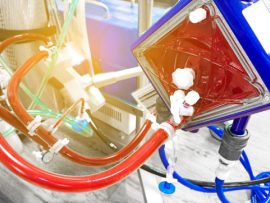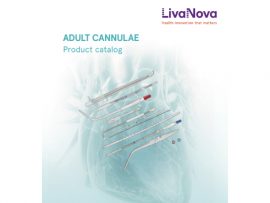Abstract Background The identification, triage, and management of cardiogenic shock (CS) are complex and resource intensive, particularly given the recent surge in the use of temporary mechanical circulatory support (tMCS)..
Lee masAbstract Abstract Objectives: To investigate whether severe hyperoxia predisposes to end-organ complications and whether these complications contribute to in-hospital mortality among cardiogenic shock (CS) patients supported in veno-arterial extracorporeal membrane..
Lee masAbstract Cardiogenic shock (CS) is a state of critical end-organ hypoperfusion caused by primary cardiac failure, in which the heart cannot generate sufficient output despite adequate preload and is associated..
Lee masVenoarterial extracorporeal membrane oxygenation (VA ECMO) provides temporary mechanical circulatory support for patients in refractory cardiogenic shock. Initiation of VA ECMO often results in increased left ventricular (LV) afterload as..
Lee masAbstract Background Veno-arterial extracorporeal membrane oxygenation (VA-ECMO) use for cardiogenic shock (CS) is increasing worldwide despite conflicting results from randomized trials, which focused on myocardial-infarction related CS (MI-CS). Methods We..
Lee masAbstract Background Mixed cardiogenic and septic shock has been shown to have a higher mortality than cardiogenic shock alone and presents a unique hemodynamic phenotype. Objectives This study aimed to..
Lee masAbstract Post cardiac surgery shock (PCS) is a life-threatening condition that may require the use of mechanical circulatory support. Venoarterial (VA) extracorporeal membrane oxygenation (ECMO) is increasingly used to treat..
Lee masAbstract Objectives To describe outcomes in patients who received venoarterial extracorporeal membrane oxygenation (VA-ECMO) for cardiogenic shock and to evaluate outcomes following programmatic changes. Design A retrospective cohort study. Setting..
Lee masAbstract OBJECTIVES Cardiogenic shock is still a major clinical challenge, despite the available devices. We developed a minimally invasive, transapical dual-lumened cannula, which can provide antegrade circulatory support and unloading..
Lee masAbstract Background: Severe poisoning can lead to catastrophic cardiovascular collapse, often progressing to multiorgan failure and death. While intensive supportive care and pharmacological intervention remain the cornerstone of management, cases of..
Lee masAbstract Extracorporeal membrane oxygenation (ECMO) is widely recognized as a life-saving measure. The use of veno-arterial extracorporeal membrane oxygenation (VA ECMO) is on the rise, serving as an effective mechanical..
Lee masAbstract Background A systemic inflammatory response can contribute to poor outcomes in an advanced stage of cardiogenic shock (CS). We investigated the efficacy of extracorporeal endotoxin and cytokine adsorption using..
Lee masAbstract Background A systemic inflammatory response can contribute to poor outcomes in an advanced stage of cardiogenic shock (CS). We investigated the efficacy of extracorporeal endotoxin and cytokine adsorption using..
Lee masAbstract Introduction Extracorporeal membrane oxygenation (ECMO) is an established therapy that supports a patient in respiratory or cardiopulmonary failure to recovery, transplant, or durable mechanical support. Prompt referral by the..
Lee masAbstract Background Immediate initiation of extracorporeal membrane oxygenation (ECMO) has not demonstrated benefit in individuals diagnosed with cardiogenic shock based on the presence of hypotension. The relationship between other hemodynamic..
Lee masAbstract Background The microaxial flow pump (mAFP) improves survival in selected patients with ST-segment elevation myocardial infarction–induced cardiogenic shock (STEMI-CS). Understanding the impact on cardiac output (CO), cardiac power output..
Lee masAbstract We investigated echocardiographic and hemodynamic effects of intraaortic balloon pump (IABP) in 26 patients with cardiogenic shock on veno-arterial membrane oxygenation (VA ECMO). Our study demonstrated an 8.1% increase..
Lee masAbstract Objective To investigate the factors contributing to the "ECMO gap," the discrepancy between successful weaning from venoarterial extracorporeal membrane oxygenation (VA-ECMO) and survival to hospital discharge, using different definitions..
Lee masAbstract Objective The use of an intra-aortic balloon pump (IABP) has been suggested to unload the left ventricle while on venoarterial extracorporeal membrane oxygenation (VA-ECMO) for cardiogenic shock (CS), leading..
Lee masAbstract While iterative developments have improved outcomes of patients with myocardial infarction, mortality in patients with acute myocardial infarction cardiogenic shock (AMI-CS) remains stubbornly high. Several promising treatments have ultimately..
Lee masAbstract Cardiogenic shock (CS) in acute myocardial infarction (AMI) is a life-threatening syndrome characterized by systemic hypoperfusion that can quickly progress to multiorgan failure and death. Various devices and configurations..
Lee masAbstract Sepsis-induced cardiomyopathy is a severe complication seen in patients with refractory septic shock, characterized by cardiac dysfunction due to an overwhelming inflammatory response secondary to infection. Despite its reversible..
Lee masAbstract Background Clinical evidence regarding predictors of successful weaning from mechanical circulatory support (MCS) is lacking. This study aimed to create a simple risk score to predict successful weaning from..
Lee masAbstract The use of veno-arterial extracorporeal membrane oxygenation (VA-ECMO) for temporary mechanical circulatory support (MCS) is a common treatment in patients with cardiogenic shock (CS) but is associated with high..
Lee masAbstract Background Approximately 6000 intensive care units (ICUs) in the United States maintain extracorporeal membrane oxygenation (ECMO) programs.1 Patients who require ECMO are among the most critically ill in the ICU...
Lee masAbstract PROFOUND HYPOTENSION AND end-organ hypoperfusion are most often the consequence of inadequate systemic blood flow from primary cardiac failure (cardiogenic shock) or hemorrhage (hemorrhagic shock). However, profound hypotension may..
Lee masAbstract The use of intra-aortic balloon pump (IABP) alongside venoarterial extracorporeal membrane oxygenation (VA-ECMO) in critically ill patients presenting refractory cardiogenic shock raises questions regarding its impact on organs perfusion...
Lee masAbstract Cardiogenic shock (CS) in patients with structural heart disease (SHD) and severe valvular abnormalities poses unique challenges to traditional mechanical circulatory support (MCS) strategies, such as intra-aortic balloon pumps..
Lee masAbstract This study conducts an in-vitro experiment using a mock circulation system that mimics human circulation to assess the veno-arterial extracorporeal membrane oxygenation (ECMO) system. This study aims to compare the hemodynamic..
Lee masIntroduction Profound hypotension and end-organ hypoperfusion is most often a consequence of inadequate systemic blood flow from primary cardiac failure (cardiogenic shock) or hemorrhage (hemorrhagic shock). However, profound hypotension may..
Lee mas

















